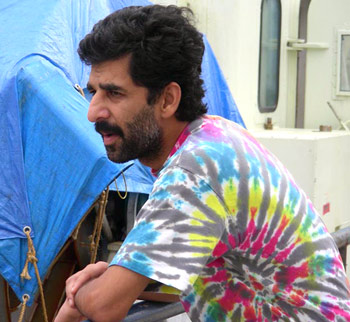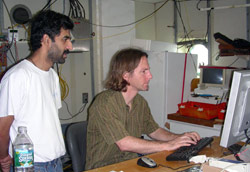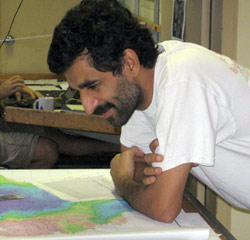|
Interview with Hanu Singh, Chief Scientist by Dan Conrad 
Can you tell me a little bit about your background and how you chose your area of research? As an undergraduate, I was planning to become a computer architect. I had been on the ocean only twice. But during the summer between my junior and senior year, I got an internship at Woods Hole Oceanographic Institution (WHOI), and I liked it so much that I decided to become an underwater robotics person. I got degrees in computer science and electrical engineering, and then I entered the Joint Program between MIT and Woods Hole in which I could mix and match offerings from both institutions. I graduated with a Ph.D. in ocean engineering. This subject brings together a variety of disciplines. I have done work in hydrodynamics, materials, and acoustics, but I remain true to my roots in electrical engineering. What fascinates you about underwater robotics? A typical team is not very big, so you get to do all different kinds of things. You actually design the whole robot—its mechanical aspects, its materials, its electrical and computer systems. So you get to see the whole system and design it from scratch. How has your creative approach fit in with the other robotics projects at WHOI? We built an AUV called SeaBed to specialize in underwater imaging. From there, we built two vehicles, Puma and Jaguar, for an expedition to the Arctic last summer during which we used them one at a time. They are the vehicles we are using on this cruise. Now we are interested in using multiple vehicles together. The engineering problems associated with such operations are what I am working on now. As Chief Scientist for this expedition, how would you describe the overall objectives of this project? One of big ones is that, when we study the ocean, we have various instruments and vehicles that we use from big ships like this one. But the cost of the ship far outweighs the cost of the equipment. Typically, when we are at sea, we operate 24 hours a day. However, we carry out our work in a serial manner; that is, there is only one asset, such as the CTD or a vehicle, being used at a time. This is not very efficient. Another problem is that when you work on mid-ocean ridges, you spend a long time—in our case, six days—in transit to the research site. So while we are on site, we need to maximize the amount of work we can get done. One way of doing that is to put multiple assets in the water at the same time, instead of just one. Some people already do that. For instance, they have an AUV doing a survey near the bottom while a tethered instrument or vehicle is deployed from the ship. But instead of putting one autonomous vehicle in the water, we want to put down ten vehicles. How do you build up to that? The answer is in small steps. We need to understand the navigation and the communications issues associated with using multiple vehicles in the water. We can simulate this on a computer, but we want to do this in a realistic scientific setting. That is why we are doing this experiment at this site—searching for, and hopefully locating, hydrothermal vents. How did you become Chief Scientist for this cruise? Being Chief Scientist is important, but it is a position among peers. On this cruise, we are doing engineering, so it is logical for me to do it. If the focus was on geology it would be someone else, or biology would be another person. Can you give us an idea of what people in your lab at WHOI were working on about a month before this expedition? Since we left port, we have been working feverishly to modify our software and hardware. How many students are working in your lab? If a young person wanted to consider a career in marine studies, what would you suggest?
|
Mailing List | Feedback | Glossary | For Teachers | About Us | Contact
© 2010 Dive and Discover™. Dive and Discover™ is a registered trademark of Woods
Hole Oceanographic Institution


